Biennials are a unique group of plants that produce only leaves the first year; in the second year, they flower, set seed, and die. This group includes foxglove, sweet rocket, sweet William, and other beloved cottage garden favorites.
What makes these varieties such treasures is that they fill the wide gap between the last of the tulips and the first of the hardy annuals in the garden. Also, the more you pick these blooms, the more they flower. They are real spring workhorses.
 Start seeds later than most, at the end of spring, and plant seedlings in the garden at the end of summer. Ideally, plants will have at least 6 to 8 weeks to establish before the first autumn frost.
Start seeds later than most, at the end of spring, and plant seedlings in the garden at the end of summer. Ideally, plants will have at least 6 to 8 weeks to establish before the first autumn frost.
Once planted, each variety will produce a large clump of foliage before cold weather sets in and then sit dormant through autumn and winter, reawakening to bloom during the later months of spring. Seeds and plants for all these varieties are easy to grow and generally hardy down to 30°F (−1°C).
In this post, I’ll tell you about some of my favorite biennial varieties and why I love them. In the comments section below, I’d love to learn which ones are your favorites.
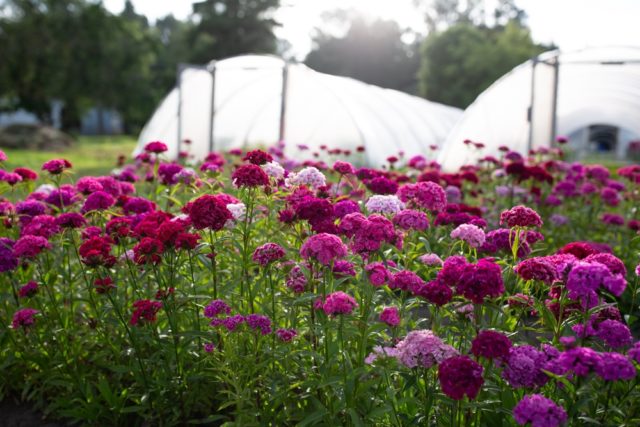 Sweet William
Sweet William
Of all the biennials I grow, these sturdy plants are the most productive in the spring garden. While they aren’t a huge showstopper when it comes to looks, they add nice color and fragrance to mixed bouquets and have an extremely long vase life. They also are easy to grow, hardy, and usually quite healthy, even with minimal care.
Harvest when just a few flowers are open on a head. This prevents the blossoms in the garden from getting damaged by rain and will give the stems a 2-week vase life.
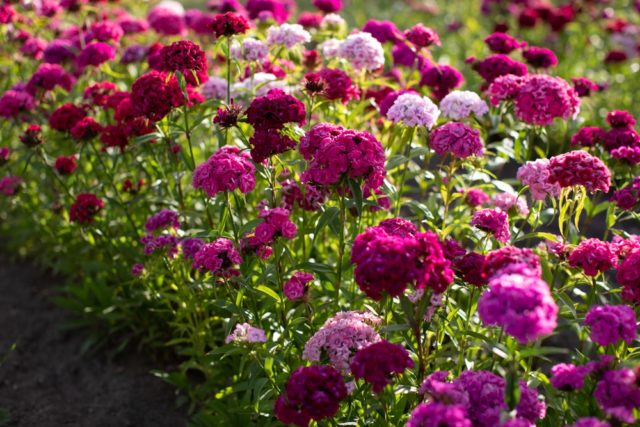 Super Duplex Mix (pictured above), an old-fashioned favorite, is both beautiful and hardworking. Highly fragrant, dense flower heads have a hydrangea-like quality and are perfect for mixed bouquets.
Super Duplex Mix (pictured above), an old-fashioned favorite, is both beautiful and hardworking. Highly fragrant, dense flower heads have a hydrangea-like quality and are perfect for mixed bouquets.
This diverse mix includes a high percentage of double flowers in shades of rich maroon, magenta, rose-pink, blush, and white.
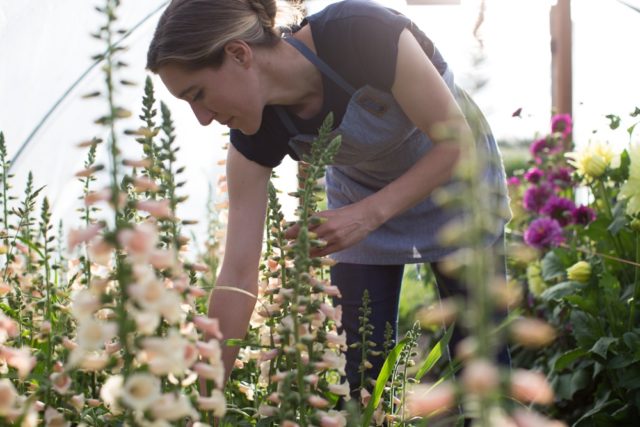 Foxglove
Foxglove
There is so much to love about this beautiful and graceful flower. When I was a little girl, it was scattered throughout our garden, and I loved watching the hungry bees nestle inside the freckled blooms to gather pollen.
The trick to getting the longest vase life from foxglove is to cut it before the bees find it. When the blooms are pollinated, they drop from the stems, so harvest early, when just a few blossoms are open. Expect a vase life of 6 to 8 days if you use flower preservative.
Please note that all parts of foxglove plants are poisonous if ingested. Wear gloves when harvesting and use caution around children and pets.
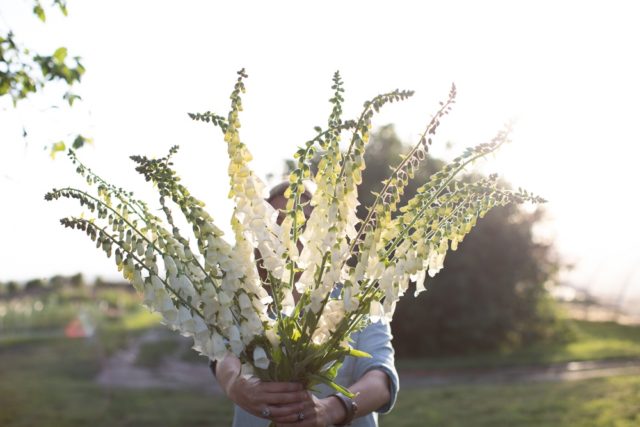 Most foxgloves are varieties of Digitalis purpurea, the wild species. There are many varieties to choose from, but my all-time favorites are ‘Alba’ and ‘Apricot Beauty’.
Most foxgloves are varieties of Digitalis purpurea, the wild species. There are many varieties to choose from, but my all-time favorites are ‘Alba’ and ‘Apricot Beauty’.
‘Alba’ (D. purpurea, pictured above) is a cottage garden favorite well-loved by pollinators. The long, graceful stems of this towering variety are loaded with creamy buds that open to pure snow white.
Unlike other foxgloves, this variety does not have any freckles inside its bell-shaped blooms. It is fantastic for wedding work and displaying en masse.
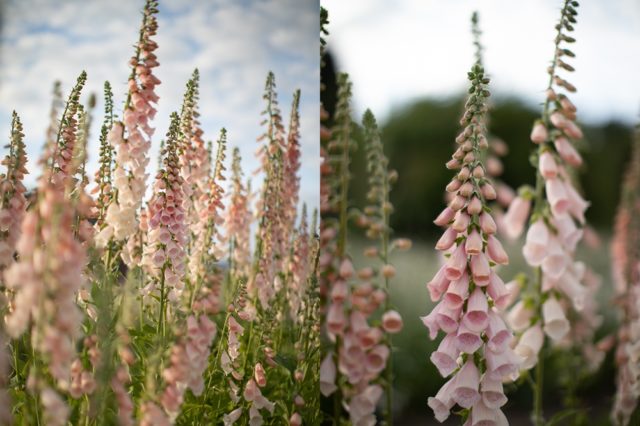 ‘Apricot Beauty’ (D. purpurea, pictured above) is an old-fashioned beauty that pumps out masses of towering stems loaded with freckled peachy-apricot blooms for a solid 2 months from late spring to early summer. We often find bumblebees sleeping in the blooms.
‘Apricot Beauty’ (D. purpurea, pictured above) is an old-fashioned beauty that pumps out masses of towering stems loaded with freckled peachy-apricot blooms for a solid 2 months from late spring to early summer. We often find bumblebees sleeping in the blooms.
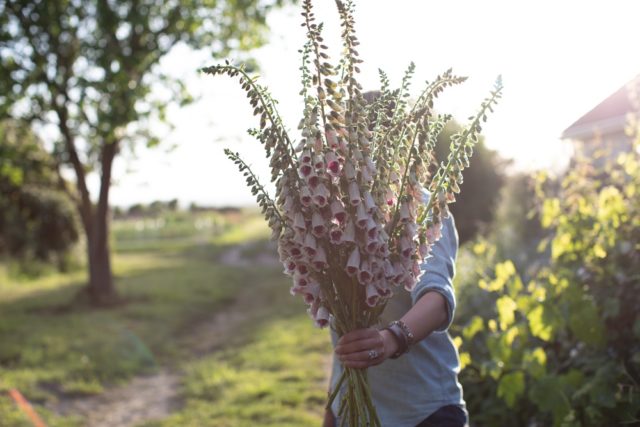 ‘Pam’s Choice’ (D. purpurea) blooms during the same period as ‘Apricot Beauty’. Its stems are smothered in white bell-shaped blooms with striking plum-colored throats. Hummingbirds love this variety!
‘Pam’s Choice’ (D. purpurea) blooms during the same period as ‘Apricot Beauty’. Its stems are smothered in white bell-shaped blooms with striking plum-colored throats. Hummingbirds love this variety!
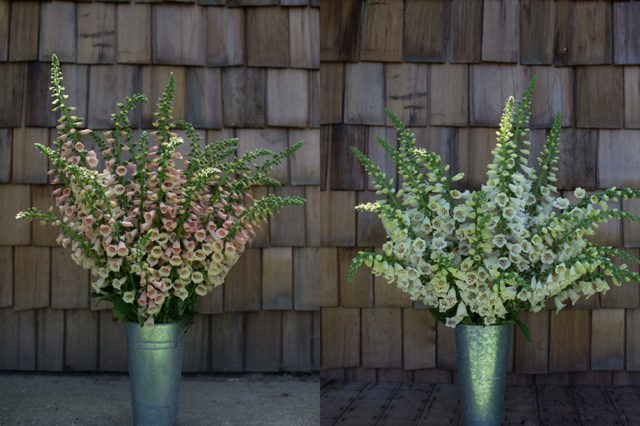 While most foxgloves are biennials, two new hybrids, ‘Dalmatian Peach’ and ‘Camelot Cream’, flower the first year from an early sowing of seed and will also produce the second year if left in place.
While most foxgloves are biennials, two new hybrids, ‘Dalmatian Peach’ and ‘Camelot Cream’, flower the first year from an early sowing of seed and will also produce the second year if left in place.
I discovered ‘Dalmatian Peach’ (pictured above, left) a few years ago and have grown it abundantly ever since. The towering stems boast soft peachy-apricot blooms that glow from the inside out. An excellent addition to bouquets and wedding work, this salmony beauty is a must-have in any cutting garden.
‘Camelot Cream’ (pictured above, right) produces masses of towering stems with creamy, freckled blooms for 2 months from late spring to early summer.
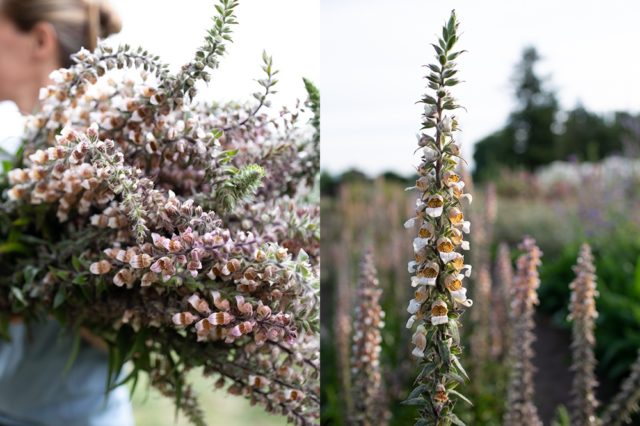 ‘Café Crème’ (D. lanata, pictured above) is loaded with creamy, hoodlike blooms brushed with golden mustard yellow and intricately detailed with chocolate veining.
‘Café Crème’ (D. lanata, pictured above) is loaded with creamy, hoodlike blooms brushed with golden mustard yellow and intricately detailed with chocolate veining.
Dark, upright stems look as if they are covered in miniature lady slipper orchids—the effect is absolutely mesmerizing. This long-lasting cut is perfect for bouquets and flowers later than most of the D. purpurea varieties.
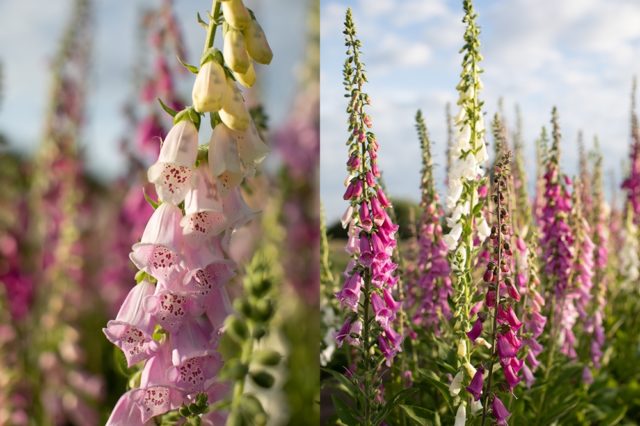 ‘Excelsior’ (D. purpurea, pictured above) is a classic, old-fashioned mix of rich purple, lilac, lavender-blush, and white spires with freckled chocolate-and-white throats. It looks identical to wild foxglove. This variety is stunning in the garden and when arranged en masse.
‘Excelsior’ (D. purpurea, pictured above) is a classic, old-fashioned mix of rich purple, lilac, lavender-blush, and white spires with freckled chocolate-and-white throats. It looks identical to wild foxglove. This variety is stunning in the garden and when arranged en masse.
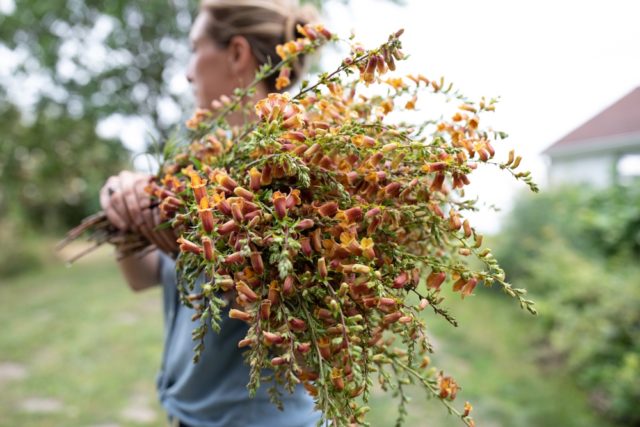 ‘Obscura Sunset’ (D. obscura, pictured above) is a gorgeous, unusual variety. Thin, sturdy, dark chocolate-colored stems are covered in rusty red bells with glowing orange-copper throats.
‘Obscura Sunset’ (D. obscura, pictured above) is a gorgeous, unusual variety. Thin, sturdy, dark chocolate-colored stems are covered in rusty red bells with glowing orange-copper throats.
Knee-high plants are on the shorter side, but what they lack in stature they make up for in their versatile coloring. This variety is perfect for flower arranging and is extremely long lasting.
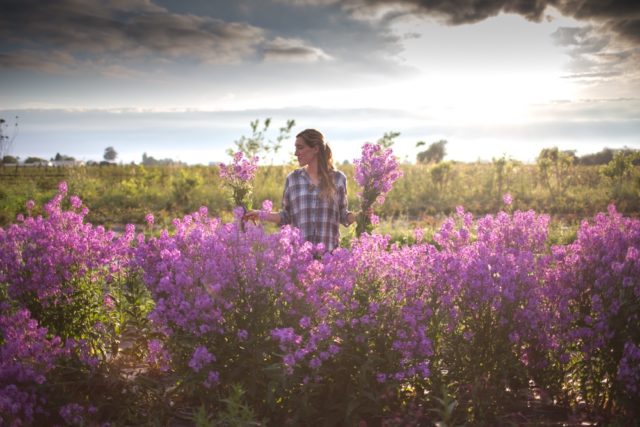 Sweet rocket
Sweet rocket
This cottage garden staple comes in white, violet, or a mix, which occasionally includes a pretty mauve-pink. Easy to grow, it’s one of the first flowers in the spring garden not grown from a bulb. Blooms are highly scented and look fantastic in bouquets.
The more you harvest, the more these plants flower. After blooms fade, stems are loaded with pretty seedpods resembling thin, shiny green beans. I like to mix them into bouquets as well.
Note that stems do lengthen a bit in water after harvest, as tulips do, so if you’re using these in bouquets, snug them down a little lower than seems right at first to allow for elongation. Sweet rocket will look good in the vase for a week or more and needs no special care.
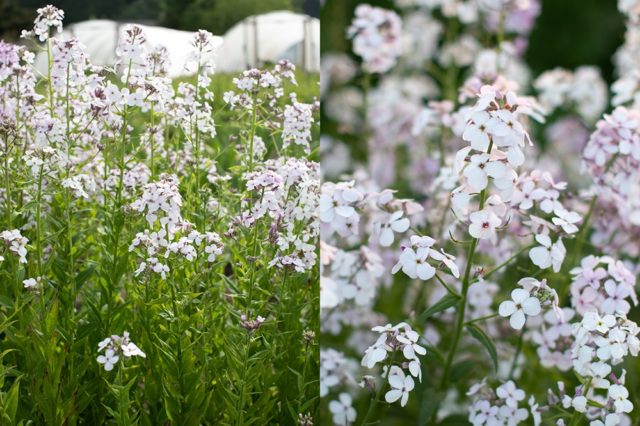 We’ve been growing ‘Pale Lavender’ (pictured above), a hard-to-find variety, for many years, and it’s one of the most beautiful biennials that bloom on our farm each spring. Towering stems are loaded with billowy flowers that are well-loved by pollinators.
We’ve been growing ‘Pale Lavender’ (pictured above), a hard-to-find variety, for many years, and it’s one of the most beautiful biennials that bloom on our farm each spring. Towering stems are loaded with billowy flowers that are well-loved by pollinators.
This old-fashioned favorite is the palest lavender-mauve with a slightly darker eye. Blooms have a sugary candy scent that lingers in the evening air.
Please note: Sweet rocket is considered invasive in some areas. If you’re unsure whether it’s invasive where you live, a simple web search will help you find the information you need.
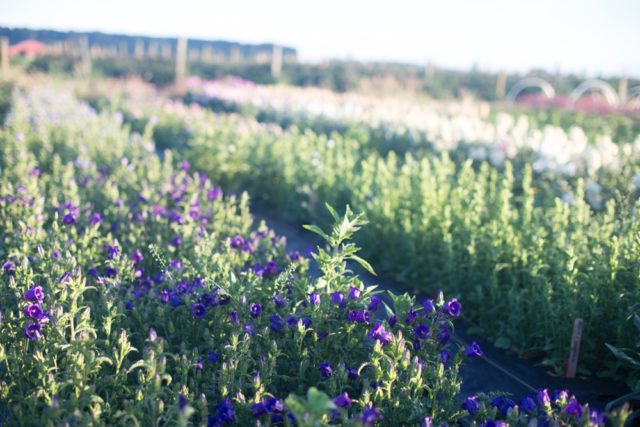 Canterbury bells
Canterbury bells
It’s easy to see why this classic is still a must-have for any cut flower grower. Both the single and the double varieties produce huge stems loaded with balloon-shaped blooms in white, pink, lavender, and purple.
The plants are quite bulky, so stake them with netting at planting time to keep them upright in heavy spring rains.
Pick when the top bud is colored and just opening. It is not unheard of for these stems to last 2 weeks in a bouquet.
While most Canterbury bells are biennials, some hybrid varieties flower the first year from an early sowing of seed.
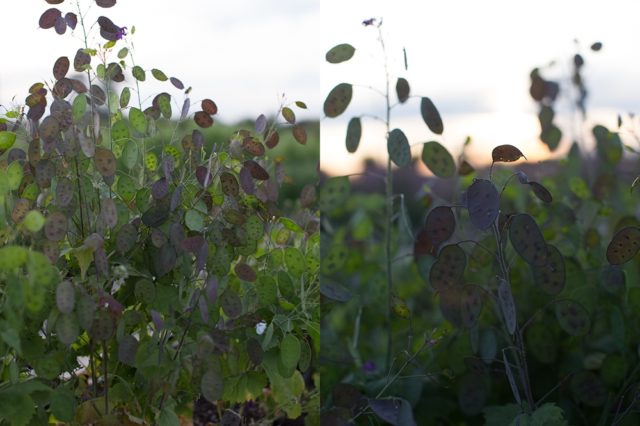 Money plant
Money plant
Grown primarily for its beautiful seedpods, this spring treasure thrives in less-than-ideal conditions, including shade and poor soil. Though flowers can be harvested in early spring, the window of bloom is very short, making it an unreliable flower crop.
I love to use the seedpods when they’re green; as they age a little on the plant, they take on a purple cast. In addition to the typical white-flowering plant that produces green pods, there is a purple-flowering type that produces darker pods.
Each plant produces 20 to 30 long stems that are loaded with seedcases. The pods last for well over a week when fresh and need no special treatment.
The stems of seedpods can also be dried for later use in autumn wreaths and bouquets. To dry, hang freshly cut stems upside down in a warm, dark place for 2 to 3 weeks or until they are firm to the touch.
Be gentle when handling them after they’ve dried because the seedpods are fragile and can fall apart easily.
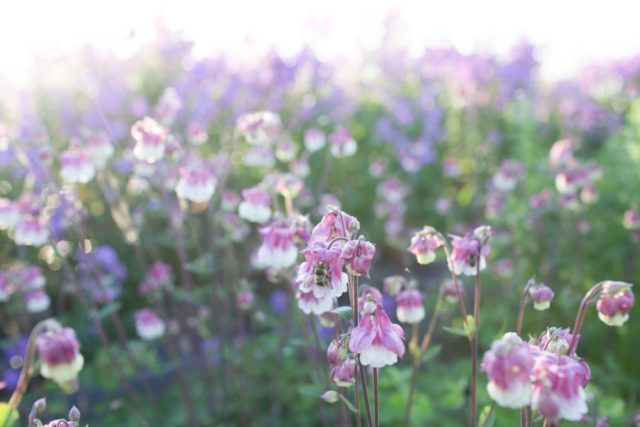 Columbine
Columbine
Although these are perennials, I have found that treating them as biennials and replanting fresh stock each season means a much greater harvest each spring. Older plants succumb to disease after a year or two, and their self-sown babies aren’t numerous enough for a meaningful crop.
For the longest vase life, cut the flowers early in development, before any begin to drop their petals.
There are many, many varieties to choose from, and almost all are good for cutting. We plan to add all of the following varieties in the future.
The Barlow Series is a lovely group of tall, double-flowered plants that often produce 7 to 10 stems each if grown in rich soil. The unusually shaped flowers are about 1.5 in (3.8 cm) wide with pointed petals, and they don’t carry the spurs typical of columbine blooms.
‘McKana’s Giant’ resembles the native mountain columbine, with flowers 3 in (8 cm) wide or even larger. They come in blue, red, pink, yellow, and white, with white or pale centers. ‘William Guiness’ is similarly shaped, with dark reddish-purple spurs, outer petals, and center.
The aptly named Tall Double Mix produces double flowers in a range of colors on stems up to 4 ft (1.2 m) tall.
‘Chocolate Soldier’ is a gorgeous, unusually shaped flower with greenish-white petals and a reddish-brown center. It grows up to about 16 in (41 cm) tall, sufficient for cutting. What makes it exceptional is that it really smells like chocolate.
The highly regarded seed house Jelitto in Germany now carries seed for all of these varieties except Tall Double Mix and will ship in packets to the U.S.
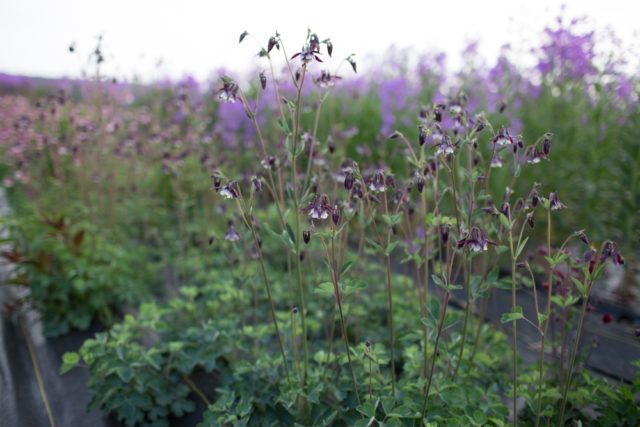 I would love to hear about your experience with this wonderful group of plants. Do you grow biennials or plan to add them to your garden this coming season? If so, what are your favorite varieties, or what new treasures are you adding to your wish list?
I would love to hear about your experience with this wonderful group of plants. Do you grow biennials or plan to add them to your garden this coming season? If so, what are your favorite varieties, or what new treasures are you adding to your wish list?
Please note: If your comment doesn’t show up right away, sit tight; we have a spam filter that requires us to approve comments before they are published.

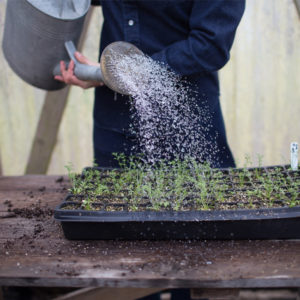

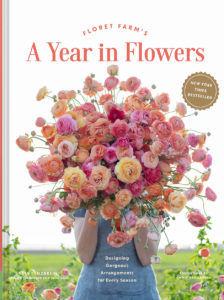
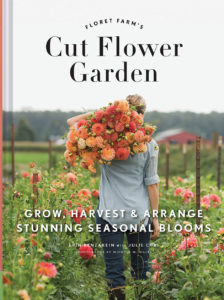


Jacquie Wierenga on
Can I purchase foxglove and Canterbury bells seeds from floret now?